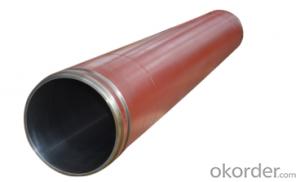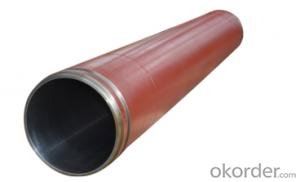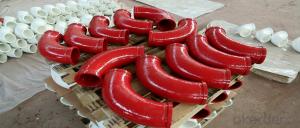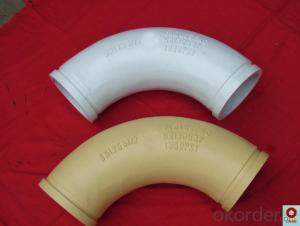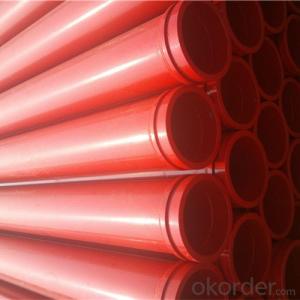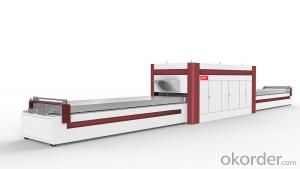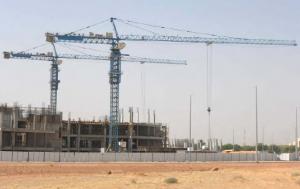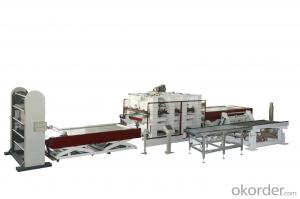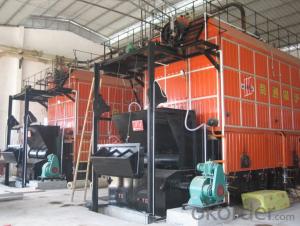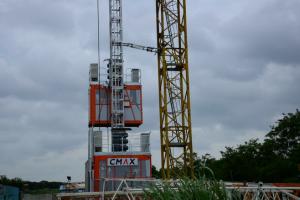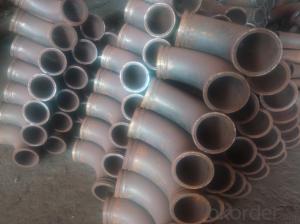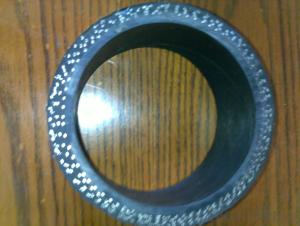PUMPING CYLINDER(SCHWING) I.D.:DN200 CR. THICKNESS :0.25MM-0.3MM LENGTH:2125MM
- Loading Port:
- Shanghai
- Payment Terms:
- TT OR LC
- Min Order Qty:
- 2 pc
- Supply Capability:
- 1000 pc/month
OKorder Service Pledge
OKorder Financial Service
You Might Also Like
Product Description:
The Concrete Pump Delivery Cylinder DN200*2125 normally made by steel material No. C45. according to customer’s requests, and also package in bundles or nude packing directly put into container.
Scope of Application of the Cylinders
The Pump Delivery Cylinder DN200*2125 is a concrete pumping for combined use with other concrete pumps in concrete pumping operations. It can be widely used in the construction of various types of concrete structures like industrial and civil buildings, bridges, roads, and other types of infrastructure.
This Cylinder DN200*2125 can only be used in concrete pump construction operations, but not in any other operations, like dragging, moving, or hoisting heavy articles or personnel. The pipe is also not allowed to be used in any location where any combustible or explosive material exists or a cave-in may occur.
Specifications:
Concrete Pump Delivery Cylinder DN200*2125
1. Capacity: 60,000~80,000cbm
2. Size: DN180, DN200, DN230..
4. Brand: SANY
5. Material: C45
6. Quenching and tempering to improve the hardness to HB241-280
7. Inner wall chrome thickness is 0.25-0.30mm, hardness HV820-900.
Product Advantages:
OKorder's Cylinders DN200*2125 Channels are durable, strong, and safety.
Main Product Features:
· Premium quality
· Prompt delivery & seaworthy packing (10-20 days)
Reliable performance
Easy to weld
High safety.
· Professional Service
· Competitive pricing
Measuring of wall thickness from the outside
Low purchase cost
FAQ:
Q1: How long about delivery time about DN200*2125?
A1: Normally we keep the raw materials for old customers and sometime we also keep stock products to make sure delivery time in any emergency cases.
Q2: How do we guarantee the quality of our Cylinders DN200*2125?
A2: We have established an advanced quality management system which conducts strict quality tests at every step, from raw materials to the final product. At the same time, we provide extensive follow-up service assurances as required.
Q3: How soon can we receive the product after purchase?
A3: Within three days of placing an order, we will book the vessel for goods. The specific shipping date is dependent upon international and government factors, but is typically10 to 30 workdays.
Q4: If we can produce some Cylinders according to customers request?
A4: Yes, we can produce Cylinders DN200*2125 according to the difference country situations to make it suitable to the market and customers. We have very professional technical team to make the design.
Q5: How to make a quick resolution for after service?
A5: OKorder and our manufacture both have overseas branches all-around of world, If needed,

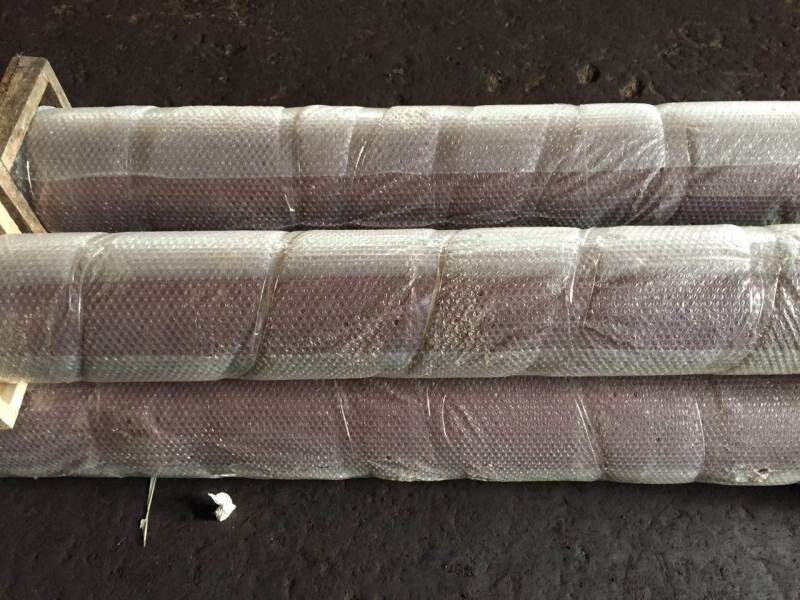

- Q:Are there any specific guidelines for the installation of pipe or hose assemblies in concrete pump spare parts?
- Concrete pump spare parts have specific guidelines for the installation of pipe or hose assemblies, which are crucial for the pump system's proper and safe functioning. To ensure this, here are some key guidelines to consider: 1. Size and Compatibility: The pipe or hose assemblies must be appropriate in size and compatible with the concrete pump system. They should meet the pump's specifications and be designed for the intended application. 2. Correct Alignment: It is essential to install the pipe or hose assemblies straight, without any kinks or bends that may restrict the flow of concrete or cause blockages, thus ensuring efficient operation. 3. Secure Connections: To prevent leaks or disconnections during operation, all connections, including fittings and couplings, should be securely tightened. It is advisable to use proper tools and techniques to ensure reliable and tight connections. 4. Support and Protection: Proper support and protection of pipe or hose assemblies are necessary to prevent damage or wear. They should be securely fastened to minimize excessive movement or vibration during pumping operations. 5. Clearances and Accessibility: Maintaining sufficient clearances between the pipe or hose assemblies and surrounding structures or equipment allows for easy inspection, maintenance, and replacement if necessary. 6. Proper Sealing: Suitable sealing materials should be used to properly seal all joints and connections. This is crucial for maintaining the pumping system's integrity and preventing any environmental or safety hazards caused by leakage. 7. Regular Inspection and Maintenance: Regularly inspecting the pipe or hose assemblies for signs of wear, damage, or degradation is important. Promptly addressing any issues ensures the continued safe operation of the concrete pump system. By following these guidelines, the proper installation of pipe or hose assemblies in concrete pump spare parts can be ensured, promoting safe and efficient concrete pumping operations. It is also advisable to consult the manufacturer's recommendations and refer to any specific guidelines provided with the spare parts.
- Q:How can a faulty accumulator affect the pumping efficiency?
- A faulty accumulator can negatively impact pumping efficiency by causing inconsistent pressure and flow rates in the system. This can lead to excessive energy consumption, reduced overall performance, and potential damage to the pump and other components.
- Q:Can I repair concrete pump spare parts instead of replacing them?
- Yes, it is possible to repair concrete pump spare parts instead of replacing them in some cases. Many concrete pump spare parts can be repaired, such as seals, gaskets, valves, and hydraulic components. However, the feasibility of repair depends on the extent of the damage and the specific part in question. Some damaged parts may be too worn or damaged to be effectively repaired, and in those cases, replacement may be necessary. It is important to consult with a professional or contact the manufacturer to determine if repair is a viable option for your specific concrete pump spare parts.
- Q:What is the purpose of a concrete pump hydraulic accumulator bladder?
- The purpose of a concrete pump hydraulic accumulator bladder is to store and release hydraulic energy, resulting in smoother and more efficient operation of the concrete pump.
- Q:Are there any specific guidelines for the installation of pistons or cylinders in concrete pump spare parts?
- Yes, there are specific guidelines for the installation of pistons or cylinders in concrete pump spare parts. These guidelines are important to ensure proper functioning and longevity of the equipment. 1. Clean and inspect: Before installing pistons or cylinders, it is crucial to thoroughly clean and inspect them for any damage or defects. Any debris or contaminants should be removed to prevent potential issues during operation. 2. Lubrication: Apply a suitable lubricant to the piston or cylinder to reduce friction and ensure smooth movement. This will also help in preventing wear and tear, enhancing the lifespan of the parts. 3. Alignment: Proper alignment of the piston or cylinder is essential. Ensure that the piston is aligned correctly with the cylinder bore to avoid any binding or excessive wear. This can be achieved by following the manufacturer's instructions or consulting a professional if necessary. 4. Torque specifications: It is important to tighten the bolts or fasteners according to the manufacturer's recommended torque specifications. Over-tightening or under-tightening can lead to problems such as leaks or mechanical failure. 5. Sealing: Use appropriate sealing materials, such as gaskets or O-rings, to ensure a proper seal between the piston and cylinder. This will prevent fluid leakage and maintain the efficiency of the equipment. 6. Testing: After installation, it is recommended to test the pistons or cylinders to ensure they are functioning correctly. This can involve performing a trial run or conducting pressure tests to check for any leaks or abnormalities. Following these guidelines will help ensure the proper installation of pistons or cylinders in concrete pump spare parts, leading to reliable and efficient operation of the equipment. It is always advisable to refer to the manufacturer's instructions or seek professional assistance if there are any doubts or concerns during the installation process.
- Q:How does a concrete pump S valve function?
- A concrete pump S valve functions by controlling the flow of concrete from the hopper to the discharge outlet. The S valve is a crucial component in the concrete pumping system as it allows for the precise and efficient delivery of concrete to the desired location. The S valve consists of two separate valves, one on each side, that are connected by a central shaft. These valves are shaped like an "S", hence the name. Each valve has a concrete outlet and a hydraulic cylinder that controls its movement. When the concrete pump is activated, the hydraulic system applies pressure to the cylinders, causing them to push the valves open. As the valves open, concrete is allowed to flow from the hopper into the pump's cylinder. Once the concrete is inside the cylinder, the hydraulic system reverses the pressure on the cylinders, causing them to retract. This movement pulls the valves closed, sealing off the cylinder and preventing any backflow of concrete. As the cylinder retracts, it also pushes the concrete inside towards the discharge outlet. The pressure created by the retraction of the cylinder forces the concrete through the outlet pipe, which leads to the desired location for pouring. The S valve's design allows for a smooth and continuous flow of concrete, without any interruption or blockages. It also provides a high level of control over the concrete placement, allowing operators to adjust the flow rate and direction as needed. Overall, the concrete pump S valve is responsible for regulating the flow of concrete, ensuring its efficient and precise delivery to the desired location. Its reliable and effective functioning is vital for successful concrete pumping operations.
- Q:How often should wear rings be replaced in a concrete pump?
- Wear rings in a concrete pump should be replaced regularly, typically every 2,000 to 3,000 hours of operation. However, the frequency may vary depending on factors such as pump usage, maintenance practices, and the quality of materials being pumped. Regular inspection and monitoring of wear ring condition are essential to determine the appropriate replacement interval.
- Q:How do I properly maintain and replace hydraulic pumps in concrete pump spare parts?
- To ensure the smooth functioning and long life of your equipment, it is crucial to properly maintain and replace hydraulic pumps in concrete pump spare parts. Here are some steps that can assist you in this process: 1. Conduct Regular Inspections: Before and after each use, visually inspect the hydraulic pump to detect any signs of wear, leaks, or damage. Additionally, check for loose bolts, damaged seals, or excessive noise during operation. 2. Adhere to Manufacturer's Guidelines: Consult the manufacturer's guidelines and recommendations regarding the maintenance and replacement of hydraulic pumps. They will provide specific instructions concerning the frequency of maintenance, lubrication, and replacement intervals. 3. Ensure Proper Lubrication: Smooth operation of hydraulic pumps requires proper lubrication. Regularly check the oil levels and refill if necessary. Utilize the recommended oil or hydraulic fluid as specified by the manufacturer. Adhere to the guidelines regarding the frequency of oil changes. 4. Maintain Regular Cleaning: Keep the hydraulic pump and its components free from debris, dust, and dirt. Employ a clean cloth or compressed air to eliminate any accumulated contaminants. This practice will help prevent damage and minimize the likelihood of clogs or blockages. 5. Replace Worn Parts: Over time, certain components of the hydraulic pump may wear out and necessitate replacement. Maintain a stock of spare parts, including seals, gaskets, and filters, to promptly replace any worn or damaged components. 6. Seek Professional Assistance: If you are uncertain about any aspect of maintaining or replacing hydraulic pumps, it is advisable to consult a professional technician or the manufacturer. They possess the expertise and knowledge to guide you through the process and ensure the best maintenance and replacement practices. Remember, regular maintenance and timely replacement of hydraulic pumps in concrete pump spare parts will not only prolong the lifespan of your equipment but also ensure safe and efficient operation on construction sites.
- Q:How can one ensure proper alignment and positioning of concrete pump spare parts during installation?
- Achieving the desired alignment and positioning of concrete pump spare parts during installation is crucial for the pump's efficient and safe operation. Here are some important steps to follow: 1. Familiarize yourself with the manufacturer's instructions: Before starting the installation process, carefully read and understand the instructions and guidelines provided by the manufacturer. These instructions will give you specific information on how to align and position the spare parts for your concrete pump model. 2. Prepare the work area properly: Clear any debris, dust, or obstacles from the work area that could hinder the installation process. A clean and organized work environment will make it easier to accurately position and align the spare parts. 3. Use appropriate lifting equipment: Concrete pump spare parts can be heavy and require special lifting equipment to prevent damage or injuries. Utilize cranes, hoists, or forklifts to lift and position the spare parts accurately and safely. 4. Employ precise measuring tools: Invest in high-quality measuring tools like laser levels, alignment guides, and precision measuring tapes. These tools will help you ensure precise alignment and positioning of the spare parts during installation. 5. Verify dimensions and specifications: Before installing any spare part, compare the dimensions and specifications provided by the manufacturer with the actual part. This will help you identify any discrepancies or potential issues that need to be addressed before installation. 6. Follow a systematic installation process: Begin with the main components of the concrete pump and gradually proceed to the spare parts. Follow a step-by-step approach, meticulously aligning and positioning each spare part according to the manufacturer's instructions. 7. Seek professional assistance if necessary: If you are uncertain about the proper alignment and positioning of certain spare parts, don't hesitate to seek professional assistance. Consulting experienced technicians or contacting the manufacturer's customer support can provide valuable guidance and ensure correct installation. 8. Perform a final inspection: Once all the spare parts are installed, conduct a thorough inspection to verify the alignment and positioning. Check for any visible gaps, misalignments, or irregularities. Immediately address any issues to ensure the proper function and longevity of the concrete pump. By following these steps and paying attention to detail, you can guarantee the proper alignment and positioning of concrete pump spare parts during installation, resulting in a dependable and efficient pump system.
- Q:How often should hopper grate springs be inspected or replaced in a concrete pump?
- To ensure optimal performance and prevent potential issues, it is essential to regularly inspect the hopper grate springs in a concrete pump. The frequency of inspection or replacement depends on factors such as pump usage, operating conditions, and manufacturer recommendations. However, a general rule is to inspect the springs at least every six months or after every 500 hours of operation, whichever comes first. During the inspection, thoroughly examine the springs for any signs of wear, damage, or deformation. Check for cracks, excessive rust, or loss of tension. If any of these issues are found, immediate replacement is necessary to maintain proper functioning of the hopper grate system. Regular inspection and timely replacement of hopper grate springs are vital to prevent clogging or blockage in the hopper, which can lead to pump malfunctions or downtime. It is advisable to consult the concrete pump manufacturer's guidelines or seek assistance from a professional technician to determine specific inspection and replacement intervals based on the pump's make and model.
1. Manufacturer Overview |
|
|---|---|
| Location | |
| Year Established | |
| Annual Output Value | |
| Main Markets | |
| Company Certifications | |
2. Manufacturer Certificates |
|
|---|---|
| a) Certification Name | |
| Range | |
| Reference | |
| Validity Period | |
3. Manufacturer Capability |
|
|---|---|
| a)Trade Capacity | |
| Nearest Port | |
| Export Percentage | |
| No.of Employees in Trade Department | |
| Language Spoken: | |
| b)Factory Information | |
| Factory Size: | |
| No. of Production Lines | |
| Contract Manufacturing | |
| Product Price Range | |
Send your message to us
PUMPING CYLINDER(SCHWING) I.D.:DN200 CR. THICKNESS :0.25MM-0.3MM LENGTH:2125MM
- Loading Port:
- Shanghai
- Payment Terms:
- TT OR LC
- Min Order Qty:
- 2 pc
- Supply Capability:
- 1000 pc/month
OKorder Service Pledge
OKorder Financial Service
Similar products
New products
Hot products
Hot Searches
Related keywords
